Great Bear Rainforest (Canada) - Study Material and Assignments
VerifiedAdded on 2023/01/16
|14
|934
|65
Presentation
AI Summary
Discover the Great Bear Rainforest in Canada, a temperate rainforest on the Pacific coast of British Columbia. This presentation provides an overview of its ecological importance, species diversity, policy initiatives, and conservation efforts. Find study material, solved assignments, essays, and more on the Great Bear Rainforest.
Contribute Materials
Your contribution can guide someone’s learning journey. Share your
documents today.
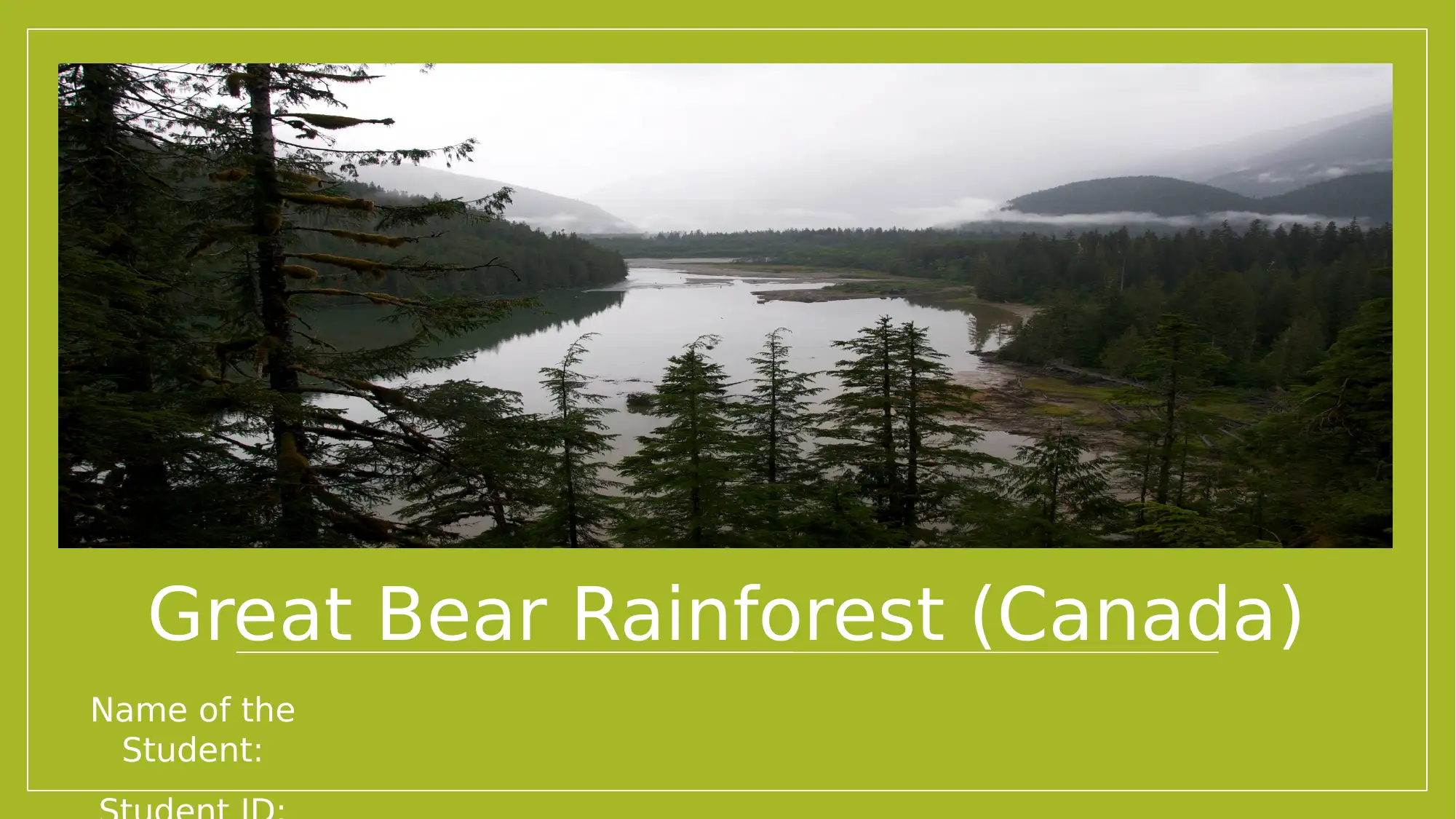
Great Bear Rainforest (Canada)
Name of the
Student:
Name of the
Student:
Secure Best Marks with AI Grader
Need help grading? Try our AI Grader for instant feedback on your assignments.
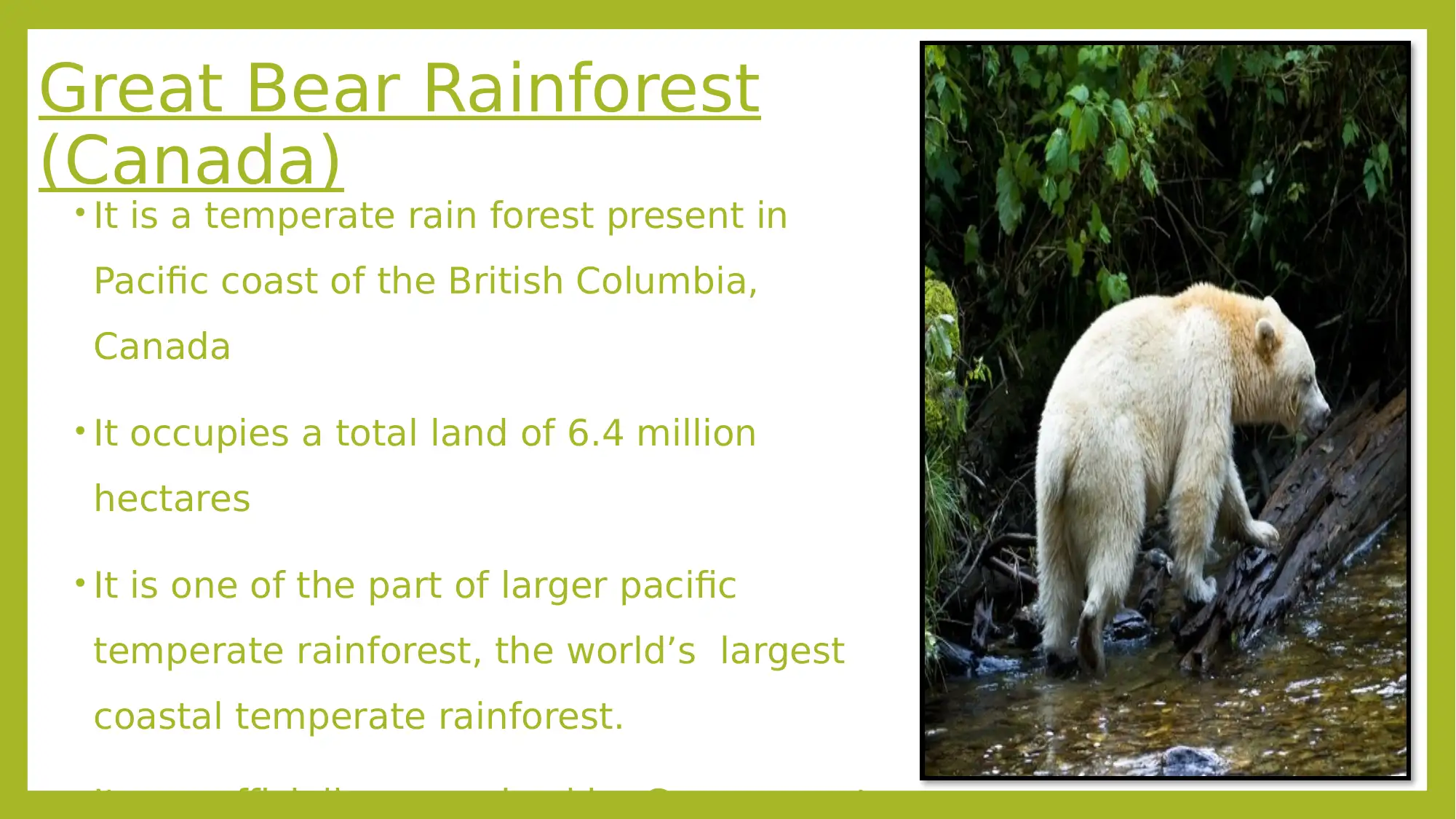
Great Bear Rainforest
(Canada)
• It is a temperate rain forest present in
Pacific coast of the British Columbia,
Canada
• It occupies a total land of 6.4 million
hectares
• It is one of the part of larger pacific
temperate rainforest, the world’s largest
coastal temperate rainforest.
• It was officially recognised by Government
(Canada)
• It is a temperate rain forest present in
Pacific coast of the British Columbia,
Canada
• It occupies a total land of 6.4 million
hectares
• It is one of the part of larger pacific
temperate rainforest, the world’s largest
coastal temperate rainforest.
• It was officially recognised by Government
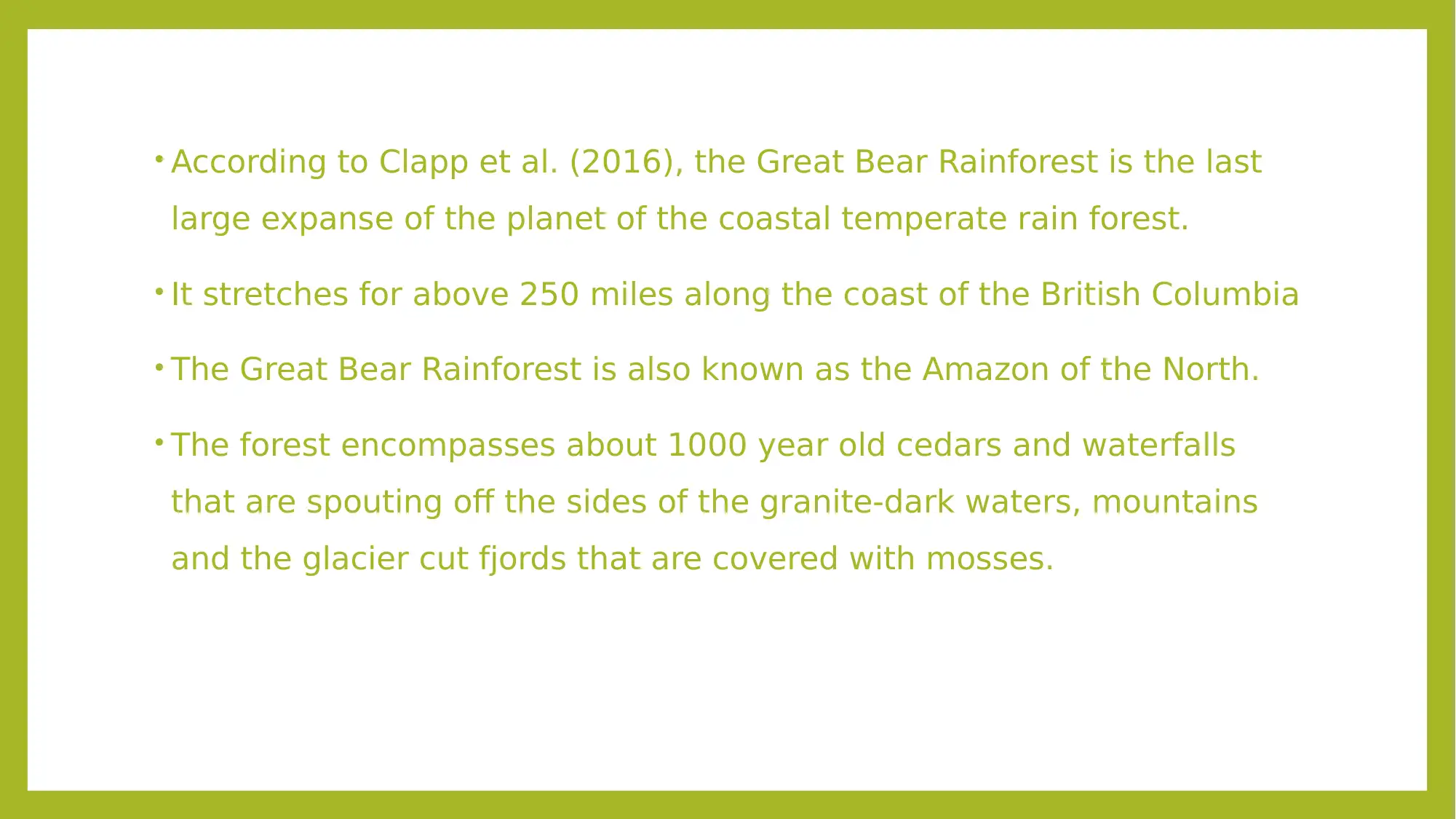
• According to Clapp et al. (2016), the Great Bear Rainforest is the last
large expanse of the planet of the coastal temperate rain forest.
• It stretches for above 250 miles along the coast of the British Columbia
• The Great Bear Rainforest is also known as the Amazon of the North.
• The forest encompasses about 1000 year old cedars and waterfalls
that are spouting off the sides of the granite-dark waters, mountains
and the glacier cut fjords that are covered with mosses.
large expanse of the planet of the coastal temperate rain forest.
• It stretches for above 250 miles along the coast of the British Columbia
• The Great Bear Rainforest is also known as the Amazon of the North.
• The forest encompasses about 1000 year old cedars and waterfalls
that are spouting off the sides of the granite-dark waters, mountains
and the glacier cut fjords that are covered with mosses.
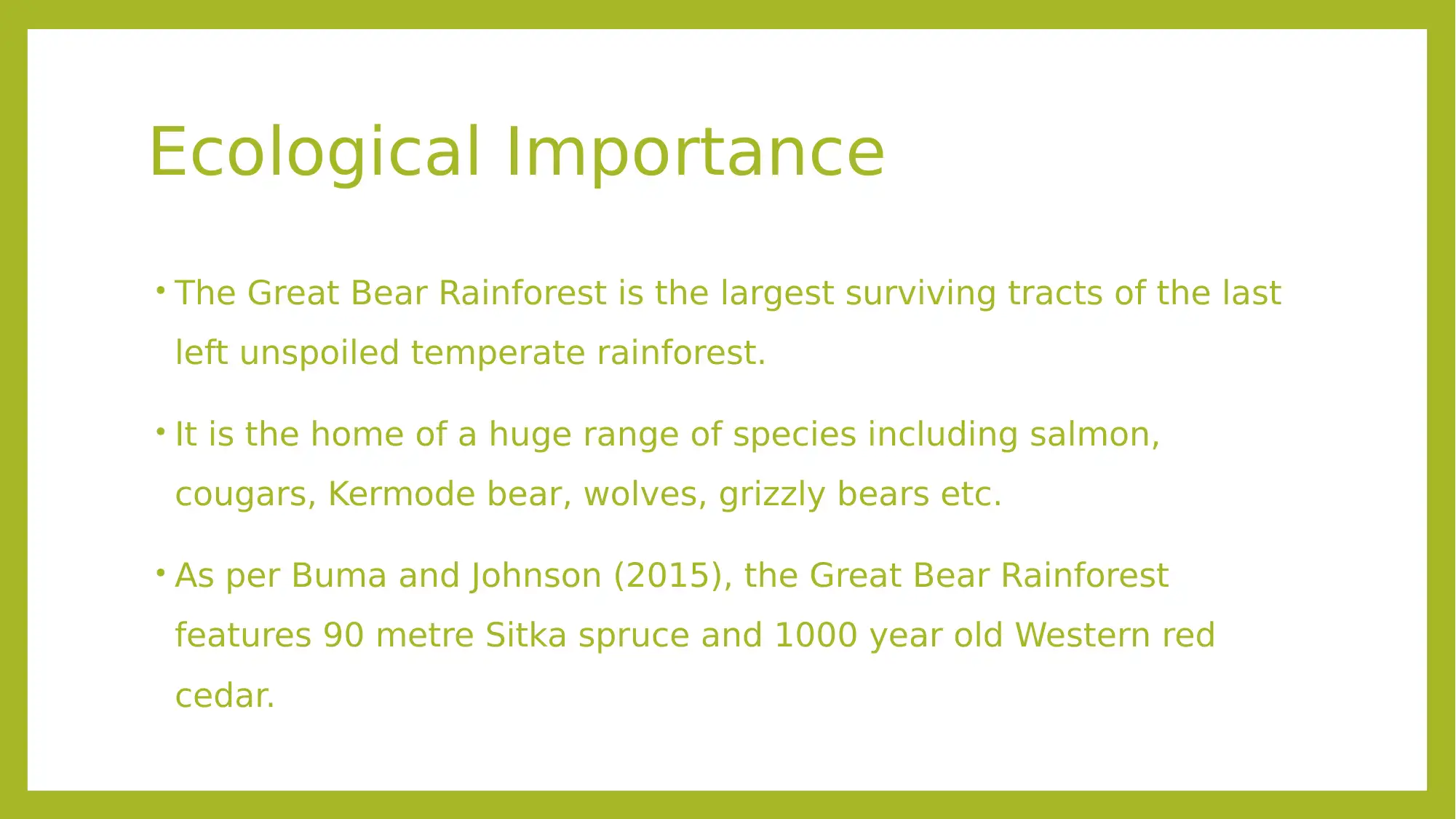
Ecological Importance
• The Great Bear Rainforest is the largest surviving tracts of the last
left unspoiled temperate rainforest.
• It is the home of a huge range of species including salmon,
cougars, Kermode bear, wolves, grizzly bears etc.
• As per Buma and Johnson (2015), the Great Bear Rainforest
features 90 metre Sitka spruce and 1000 year old Western red
cedar.
• The Great Bear Rainforest is the largest surviving tracts of the last
left unspoiled temperate rainforest.
• It is the home of a huge range of species including salmon,
cougars, Kermode bear, wolves, grizzly bears etc.
• As per Buma and Johnson (2015), the Great Bear Rainforest
features 90 metre Sitka spruce and 1000 year old Western red
cedar.
Secure Best Marks with AI Grader
Need help grading? Try our AI Grader for instant feedback on your assignments.
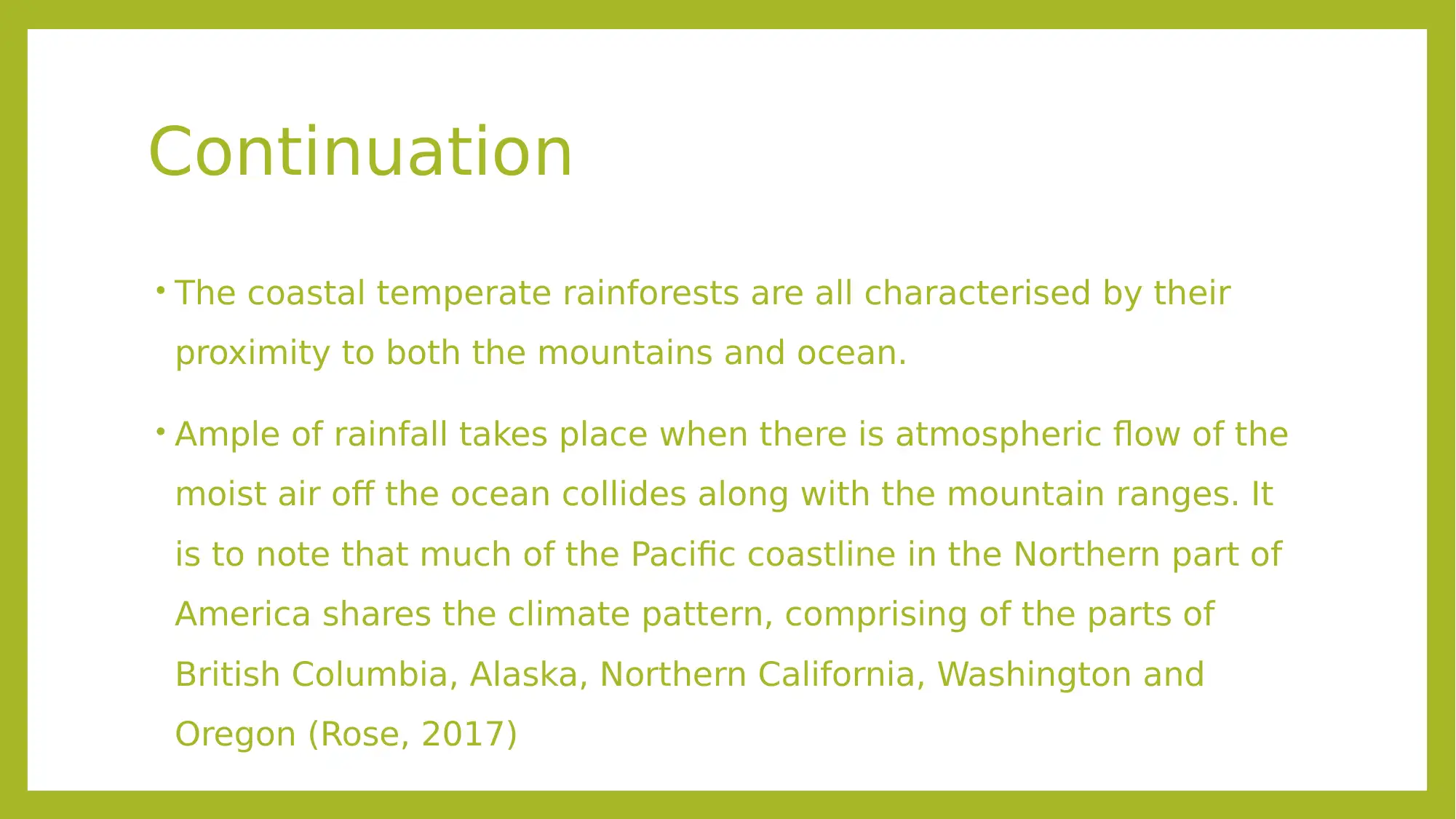
Continuation
• The coastal temperate rainforests are all characterised by their
proximity to both the mountains and ocean.
• Ample of rainfall takes place when there is atmospheric flow of the
moist air off the ocean collides along with the mountain ranges. It
is to note that much of the Pacific coastline in the Northern part of
America shares the climate pattern, comprising of the parts of
British Columbia, Alaska, Northern California, Washington and
Oregon (Rose, 2017)
• The coastal temperate rainforests are all characterised by their
proximity to both the mountains and ocean.
• Ample of rainfall takes place when there is atmospheric flow of the
moist air off the ocean collides along with the mountain ranges. It
is to note that much of the Pacific coastline in the Northern part of
America shares the climate pattern, comprising of the parts of
British Columbia, Alaska, Northern California, Washington and
Oregon (Rose, 2017)
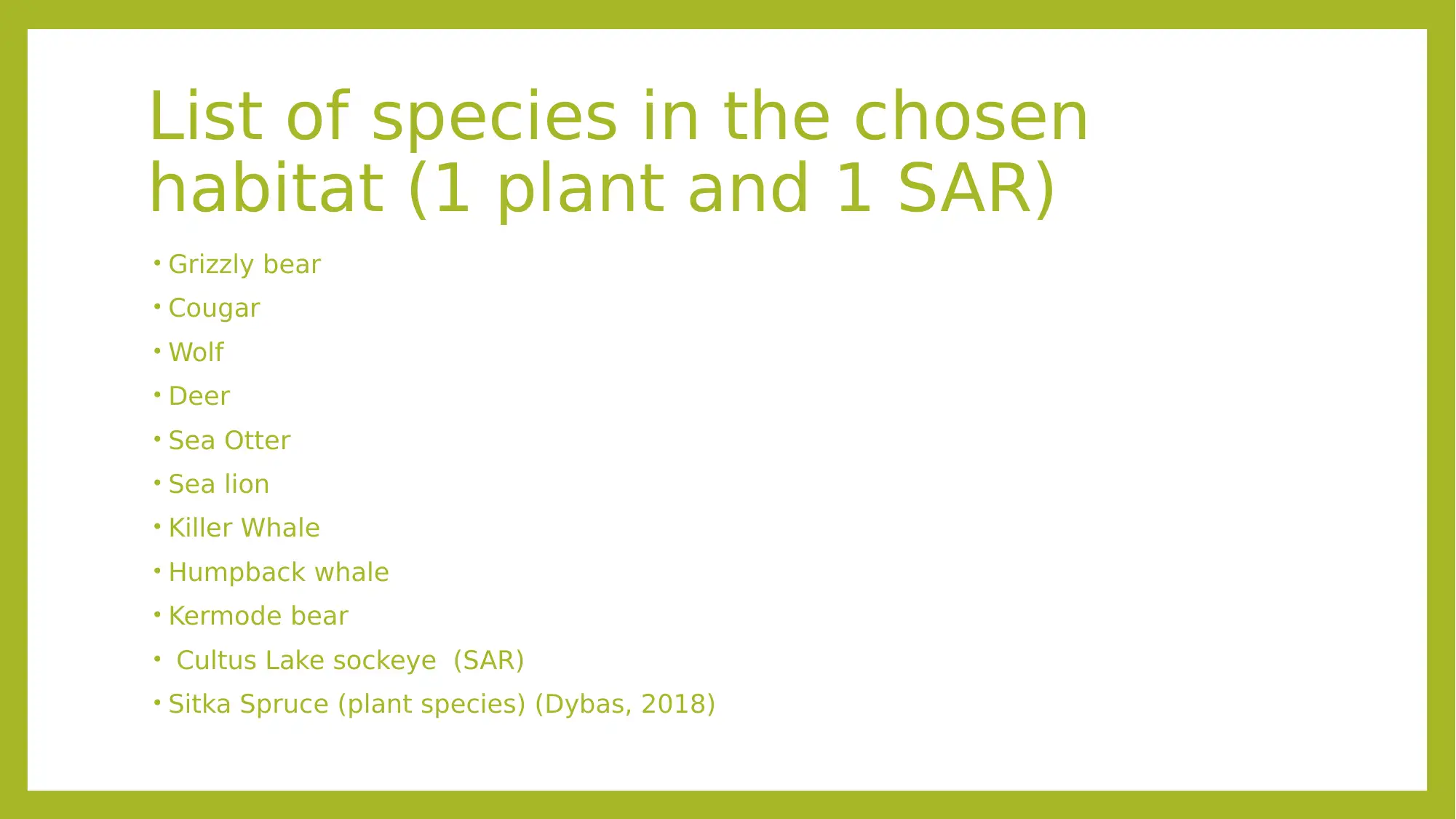
List of species in the chosen
habitat (1 plant and 1 SAR)
• Grizzly bear
• Cougar
• Wolf
• Deer
• Sea Otter
• Sea lion
• Killer Whale
• Humpback whale
• Kermode bear
• Cultus Lake sockeye (SAR)
• Sitka Spruce (plant species) (Dybas, 2018)
habitat (1 plant and 1 SAR)
• Grizzly bear
• Cougar
• Wolf
• Deer
• Sea Otter
• Sea lion
• Killer Whale
• Humpback whale
• Kermode bear
• Cultus Lake sockeye (SAR)
• Sitka Spruce (plant species) (Dybas, 2018)
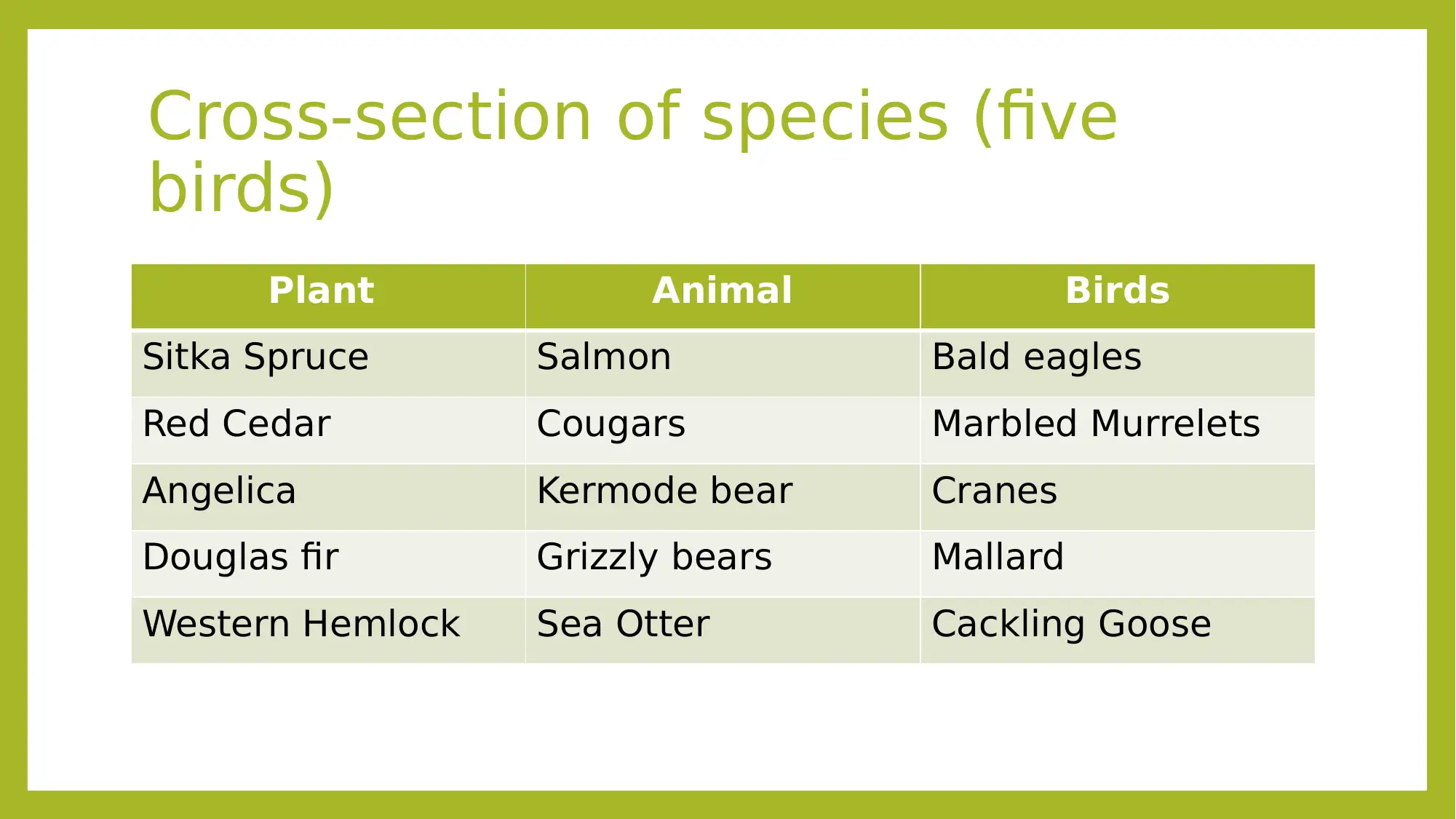
Cross-section of species (five
birds)
Plant Animal Birds
Sitka Spruce Salmon Bald eagles
Red Cedar Cougars Marbled Murrelets
Angelica Kermode bear Cranes
Douglas fir Grizzly bears Mallard
Western Hemlock Sea Otter Cackling Goose
birds)
Plant Animal Birds
Sitka Spruce Salmon Bald eagles
Red Cedar Cougars Marbled Murrelets
Angelica Kermode bear Cranes
Douglas fir Grizzly bears Mallard
Western Hemlock Sea Otter Cackling Goose
Paraphrase This Document
Need a fresh take? Get an instant paraphrase of this document with our AI Paraphraser
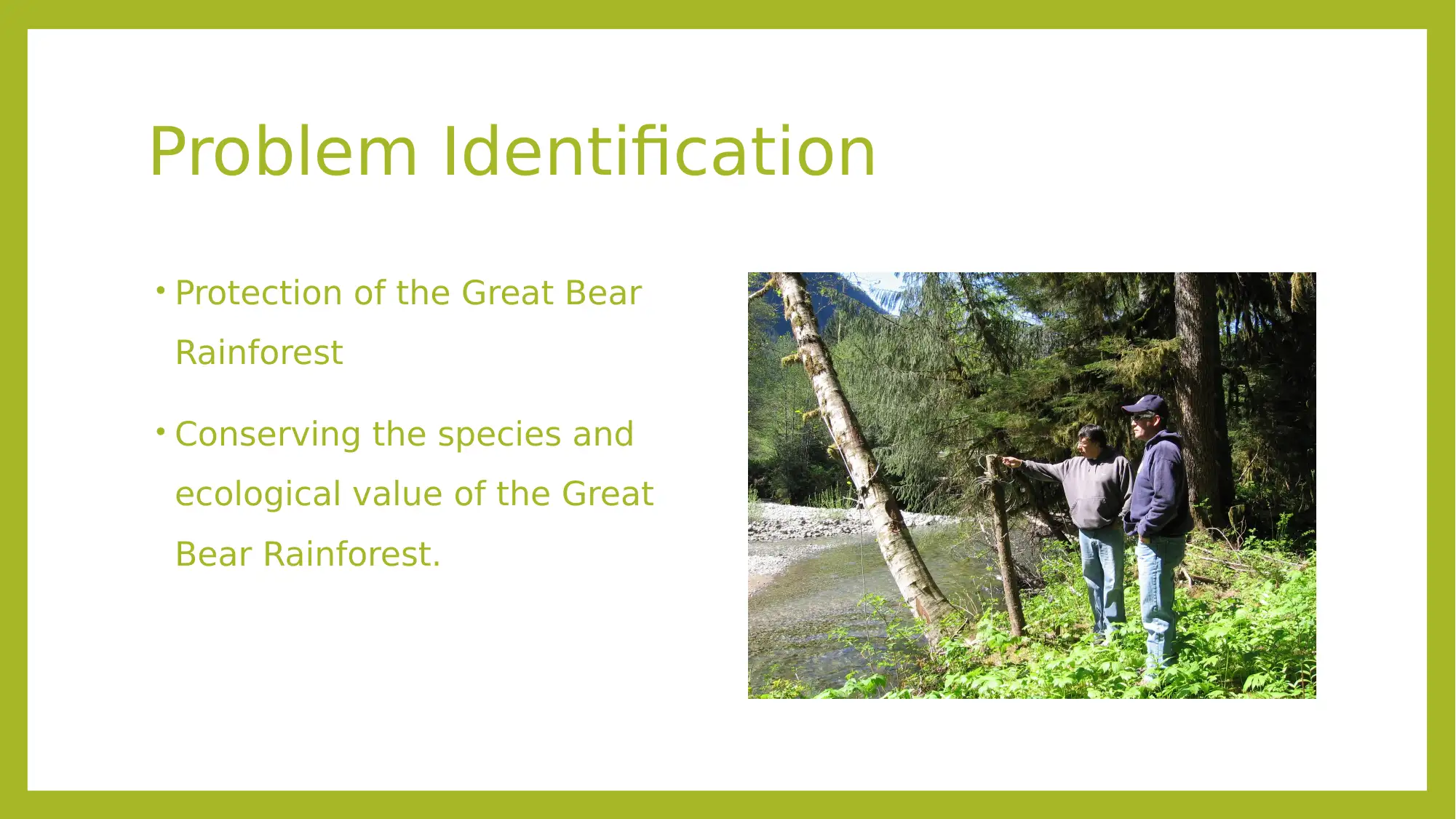
Problem Identification
• Protection of the Great Bear
Rainforest
• Conserving the species and
ecological value of the Great
Bear Rainforest.
• Protection of the Great Bear
Rainforest
• Conserving the species and
ecological value of the Great
Bear Rainforest.
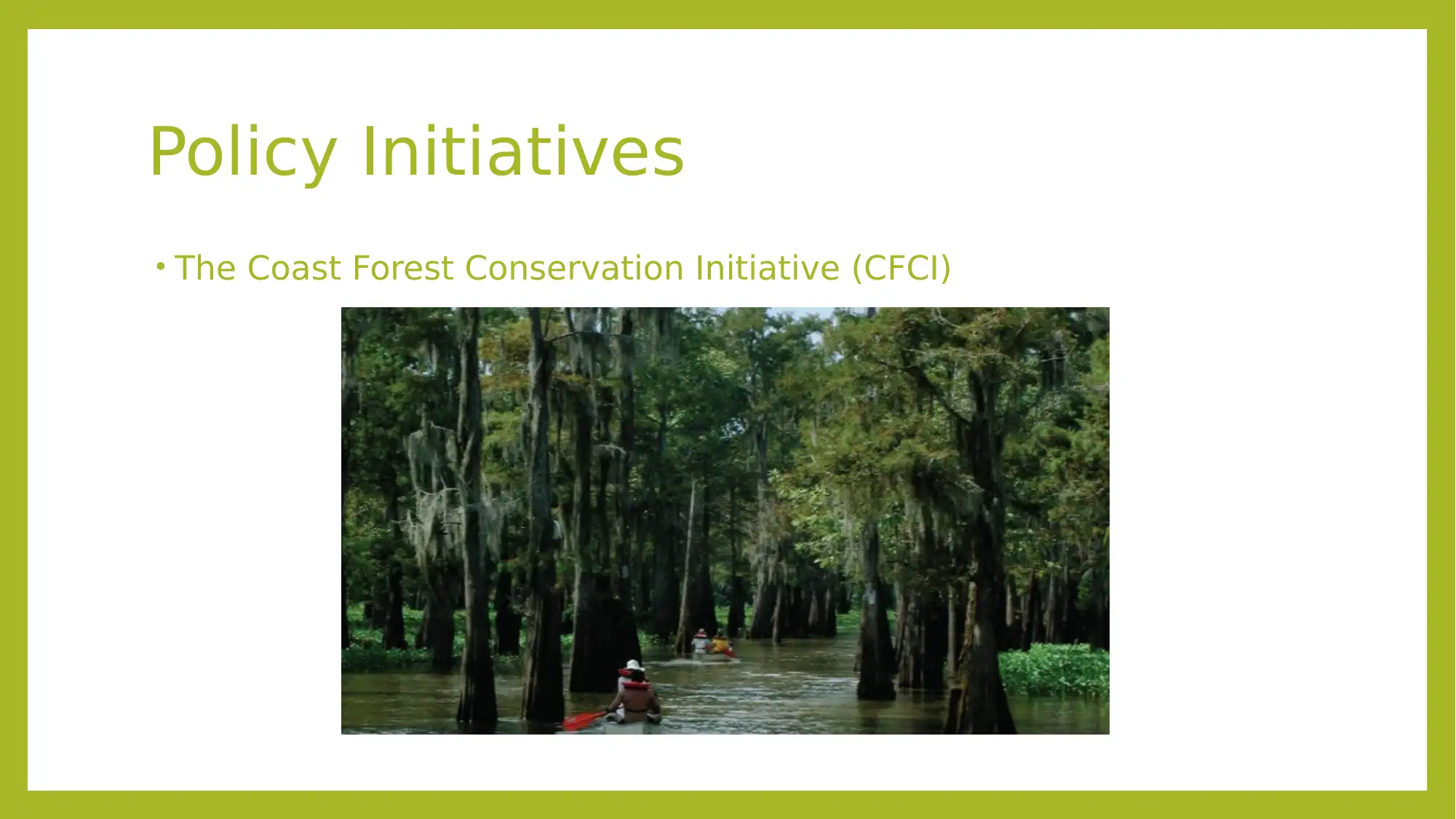
Policy Initiatives
• The Coast Forest Conservation Initiative (CFCI)
• The Coast Forest Conservation Initiative (CFCI)
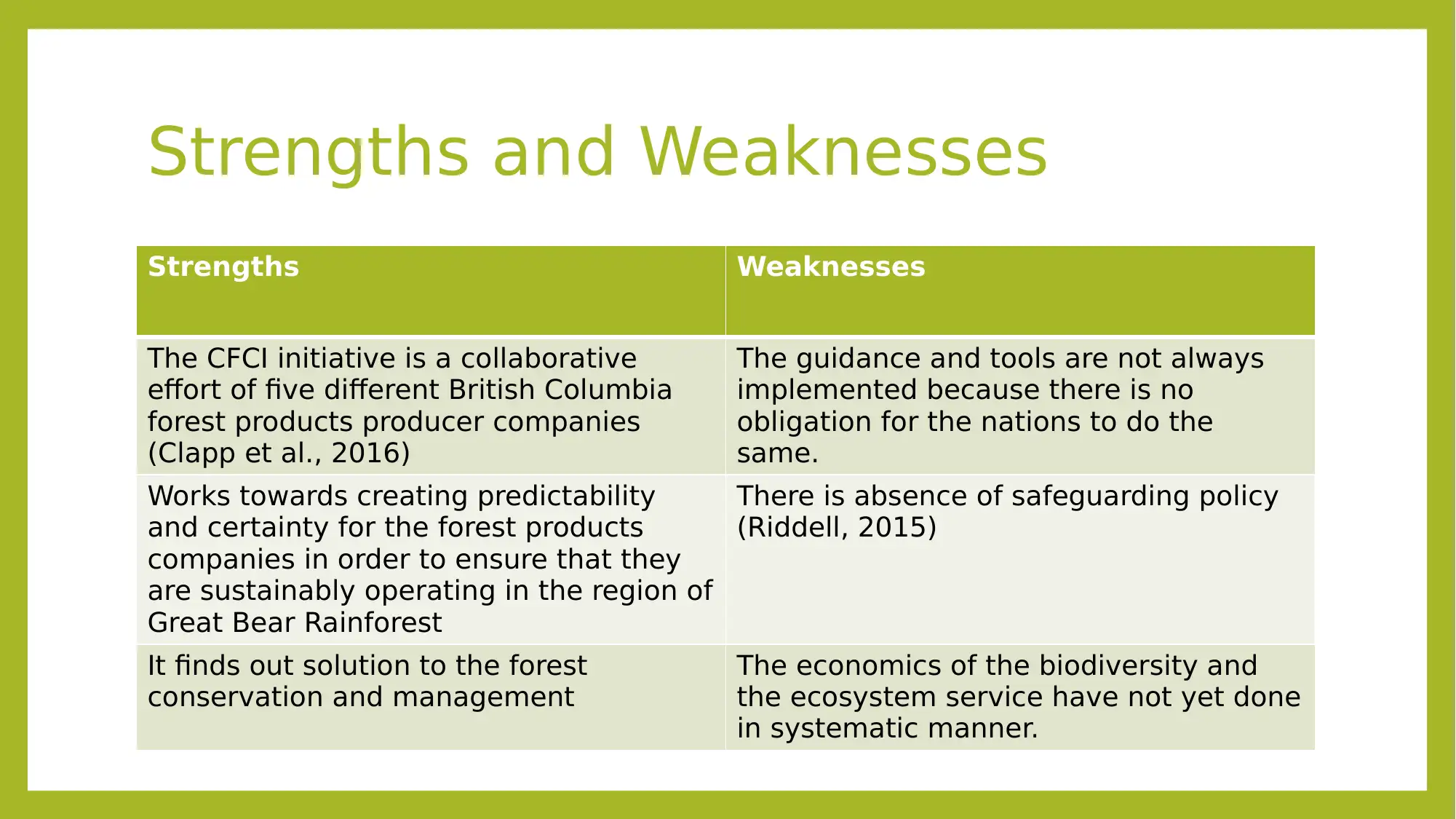
Strengths and Weaknesses
Strengths Weaknesses
The CFCI initiative is a collaborative
effort of five different British Columbia
forest products producer companies
(Clapp et al., 2016)
The guidance and tools are not always
implemented because there is no
obligation for the nations to do the
same.
Works towards creating predictability
and certainty for the forest products
companies in order to ensure that they
are sustainably operating in the region of
Great Bear Rainforest
There is absence of safeguarding policy
(Riddell, 2015)
It finds out solution to the forest
conservation and management
The economics of the biodiversity and
the ecosystem service have not yet done
in systematic manner.
Strengths Weaknesses
The CFCI initiative is a collaborative
effort of five different British Columbia
forest products producer companies
(Clapp et al., 2016)
The guidance and tools are not always
implemented because there is no
obligation for the nations to do the
same.
Works towards creating predictability
and certainty for the forest products
companies in order to ensure that they
are sustainably operating in the region of
Great Bear Rainforest
There is absence of safeguarding policy
(Riddell, 2015)
It finds out solution to the forest
conservation and management
The economics of the biodiversity and
the ecosystem service have not yet done
in systematic manner.
Secure Best Marks with AI Grader
Need help grading? Try our AI Grader for instant feedback on your assignments.
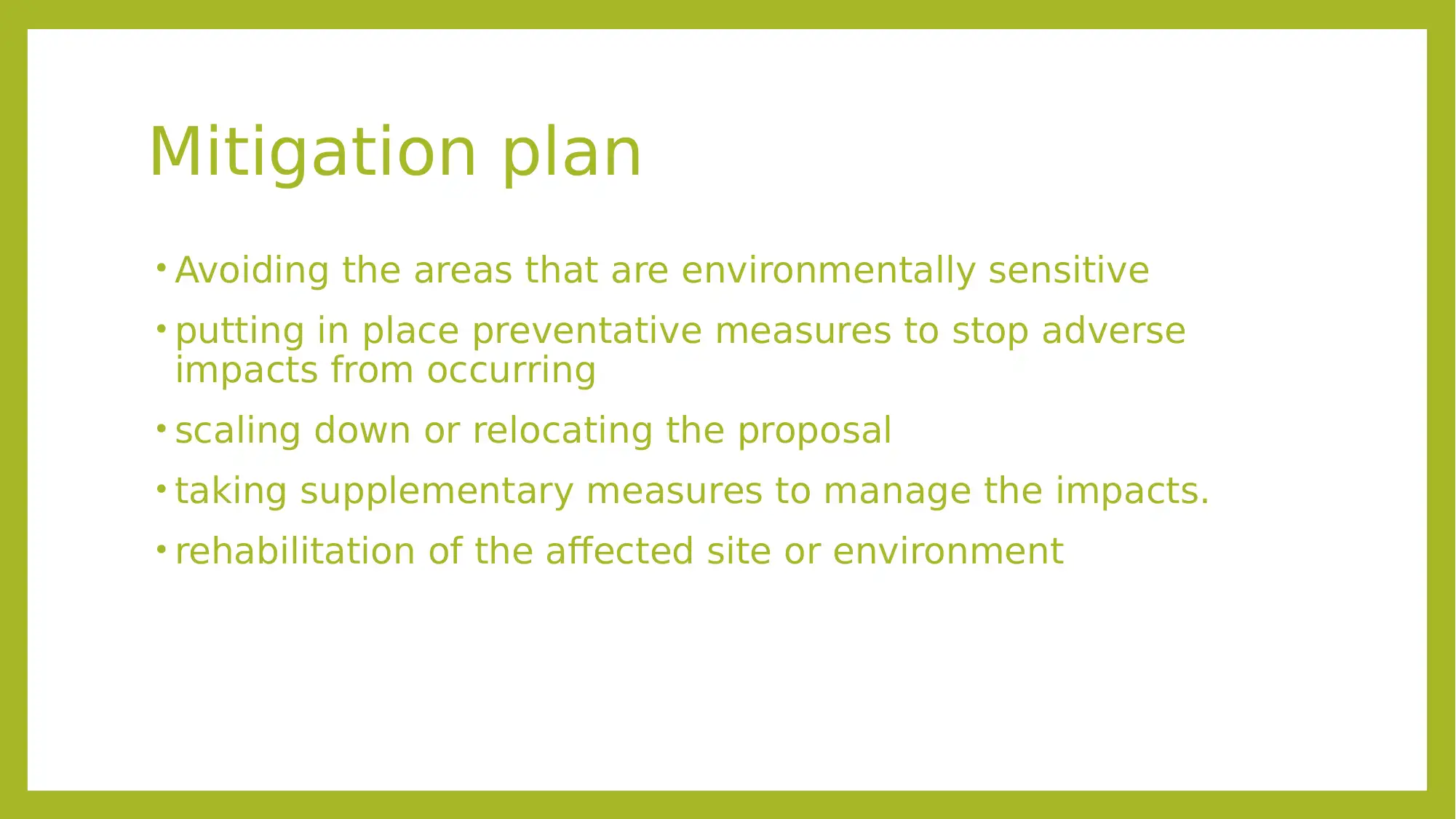
Mitigation plan
• Avoiding the areas that are environmentally sensitive
• putting in place preventative measures to stop adverse
impacts from occurring
• scaling down or relocating the proposal
• taking supplementary measures to manage the impacts.
• rehabilitation of the affected site or environment
• Avoiding the areas that are environmentally sensitive
• putting in place preventative measures to stop adverse
impacts from occurring
• scaling down or relocating the proposal
• taking supplementary measures to manage the impacts.
• rehabilitation of the affected site or environment

Compensation plan
• Monetary payments- The different range of offsets that can
be negotiated along with the affected communities.
• Site remediation bonds- The measures of Mitigation need to
be directed at the prevention of contamination as well as the
provision for clean up at the time of decommissioning. Bond
system can be used for ensuring that ample of funds are
available for the mitigation.
• Resettlement plan- Resettlement plan is required for
ensuring that no one is worse off than before.
• Monetary payments- The different range of offsets that can
be negotiated along with the affected communities.
• Site remediation bonds- The measures of Mitigation need to
be directed at the prevention of contamination as well as the
provision for clean up at the time of decommissioning. Bond
system can be used for ensuring that ample of funds are
available for the mitigation.
• Resettlement plan- Resettlement plan is required for
ensuring that no one is worse off than before.
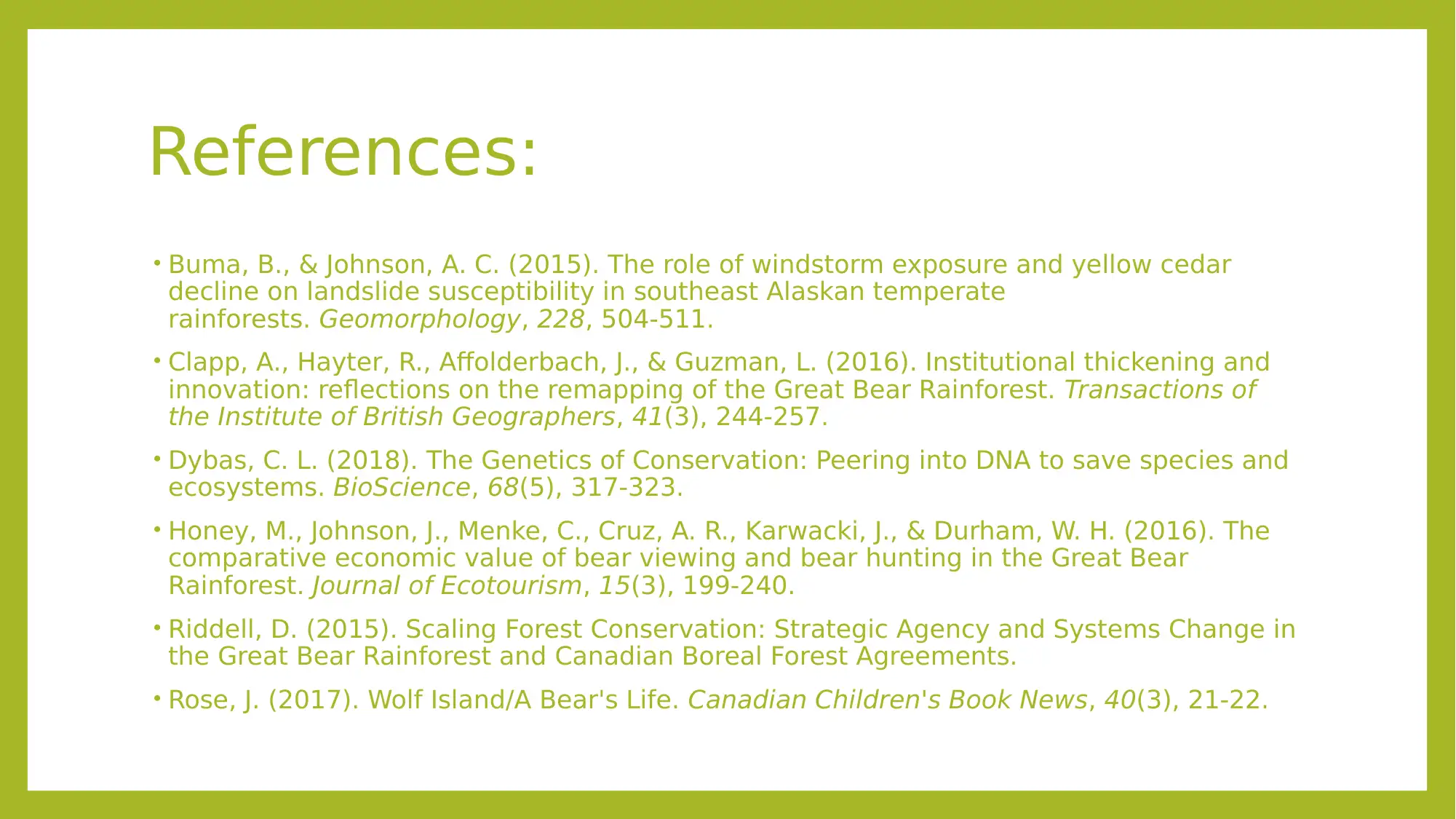
References:
• Buma, B., & Johnson, A. C. (2015). The role of windstorm exposure and yellow cedar
decline on landslide susceptibility in southeast Alaskan temperate
rainforests. Geomorphology, 228, 504-511.
• Clapp, A., Hayter, R., Affolderbach, J., & Guzman, L. (2016). Institutional thickening and
innovation: reflections on the remapping of the Great Bear Rainforest. Transactions of
the Institute of British Geographers, 41(3), 244-257.
• Dybas, C. L. (2018). The Genetics of Conservation: Peering into DNA to save species and
ecosystems. BioScience, 68(5), 317-323.
• Honey, M., Johnson, J., Menke, C., Cruz, A. R., Karwacki, J., & Durham, W. H. (2016). The
comparative economic value of bear viewing and bear hunting in the Great Bear
Rainforest. Journal of Ecotourism, 15(3), 199-240.
• Riddell, D. (2015). Scaling Forest Conservation: Strategic Agency and Systems Change in
the Great Bear Rainforest and Canadian Boreal Forest Agreements.
• Rose, J. (2017). Wolf Island/A Bear's Life. Canadian Children's Book News, 40(3), 21-22.
• Buma, B., & Johnson, A. C. (2015). The role of windstorm exposure and yellow cedar
decline on landslide susceptibility in southeast Alaskan temperate
rainforests. Geomorphology, 228, 504-511.
• Clapp, A., Hayter, R., Affolderbach, J., & Guzman, L. (2016). Institutional thickening and
innovation: reflections on the remapping of the Great Bear Rainforest. Transactions of
the Institute of British Geographers, 41(3), 244-257.
• Dybas, C. L. (2018). The Genetics of Conservation: Peering into DNA to save species and
ecosystems. BioScience, 68(5), 317-323.
• Honey, M., Johnson, J., Menke, C., Cruz, A. R., Karwacki, J., & Durham, W. H. (2016). The
comparative economic value of bear viewing and bear hunting in the Great Bear
Rainforest. Journal of Ecotourism, 15(3), 199-240.
• Riddell, D. (2015). Scaling Forest Conservation: Strategic Agency and Systems Change in
the Great Bear Rainforest and Canadian Boreal Forest Agreements.
• Rose, J. (2017). Wolf Island/A Bear's Life. Canadian Children's Book News, 40(3), 21-22.
Paraphrase This Document
Need a fresh take? Get an instant paraphrase of this document with our AI Paraphraser

Thank You
1 out of 14
Your All-in-One AI-Powered Toolkit for Academic Success.
+13062052269
info@desklib.com
Available 24*7 on WhatsApp / Email
![[object Object]](/_next/static/media/star-bottom.7253800d.svg)
Unlock your academic potential
© 2024 | Zucol Services PVT LTD | All rights reserved.